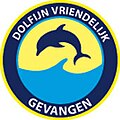Countries of usage
Australia
Some Australian tuna brands self-certify as "Dolphin Safe" or "Dolphin Friendly". Dolphins generally don't associate with tuna in the regions where tuna is predominantly sourced for the Australian market. [35]
| Labels | |
|---|---|
 | This label is used on Greenseas tuna cans in Australia. According to Greenseas, the tuna is not caught in the Eastern Tropical Pacific Ocean, nor are driftnets or gillnets used during the capture. The tuna is caught in either Australian waters or in the Western Pacific Ocean. Greenseas meets the standards set by the Earth Island Institute mentioned above. [36] |
| This label is used on John West Australia tuna cans. According to John West Australia, the tuna is caught using purse seine nets, with the exception being their pole and line caught range. [36] [37] | |
Netherlands
| Labels | |
|---|---|
 | A Dutch label used by Princes Group on tuna cans. The text translates to "Caught dolphin friendly". More often, the label is in English and Princes products are sold in many European countries, especially the United Kingdom. According to the company, the label assures that no dolphins were chased or netted while fishing for the tuna, that the boats try to fish for tuna only when no dolphins are present, and that when dolphins accidentally end up in nets, they are released. It also meets the standards set by the Earth Island Institute mentioned above. [36] [38] |
New Zealand
| Labels | |
|---|---|
 | Sealord, a major fishing company in New Zealand, has a dolphin friendly label. The company states that they purchase tuna from companies that are certified and monitored by the Earth Island Institute. [36] [39] |
United Kingdom
Virtually all canned tuna in the UK is labelled as dolphin-safe because the market is almost exclusively skipjack tuna. It is thus not implicated in the dolphin by-catch problem associated with the yellowfin tuna of the Eastern Tropical Pacific consumed in the USA. The concerns being addressed in the UK are different from those in the USA: they are preventative to ensure that tuna sold does not become unsafe for dolphins, rather than rectifying an existing environmental problem. [2]
United States
The dolphin-safe movement in the U.S. was led by environmental and consumer groups in response to the use of total encirclement netting. With this method, fishermen surrounded dolphin pods along with the tuna they were catching and the dolphins were given no chance to escape before the nets were lifted. This resulted in large numbers of dolphins being killed, imperiling the survival of entire species of dolphin, specifically in the Eastern Tropical Pacific.
In 1990, the U.S. passed the Dolphin Protection Consumer Information Act (DPCIA). [40] The law had three main provisions:
- Protecting dolphins from capture by purse seine nets.
- Providing labeling standards for tuna exported from or sold in the U.S.
- Setting penalties for noncompliance.
This protected dolphins in U.S. waters, but canneries were free to purchase tuna from domestic and foreign fisheries, so the U.S. regulations could not assure U.S. consumers they were purchasing dolphin-safe tuna. [24] However, the US does have strict provisions for reviewing tuna imports, including requiring statements by onboard independent observers (most tuna purse seine vessels in areas that export tuna to the US now have observers onboard), as well as strong fraud protection laws against false claims of Dolphin Safe. [8]
| Labels | |
|---|---|
 | The United States Department of Commerce dolphins safe label was established in 1990. Standards for the label state that tuna caught using purse seine fishing methods within the Eastern Tropical Pacific Ocean did not involve the deliberate netting or circling of any dolphins. This must have been verified by an observer from the National Marine Fisheries Service on the fishing vessel that caught the fish. Tuna caught using a different method or in most other ocean areas may be given this label without any outside observation. [41] |
 | The Flipper Seal of Approval dolphin safe label is an initiative by the organization EarthTrust. Most notable requirements are that it does not allow tuna caught using driftnets, gillnets, by the intentional setting of purse seine nets on dolphins, or, in the Eastern Tropical Pacific Ocean, any method except for hook and line fishing. Independent observers from EarthTrust must be allowed to monitor the fishing process. [42] The label also features the character, Flipper. |
 | This dolphin safe tuna label is an initiative from the Earth Island Institute. Requirements are that dolphins may not be intentionally chased, circled or netted; driftnets and gillnets cannot be used. Fish from a dolphin unfriendly source may not be added at any stage. This label has come under scrutiny by the World Trade Organization and environmental groups in the U.S. for failing to ensure that dolphins are not harmed and for failing to account for non-dolphin bycatch. [43] These claims do not take into account that the Dolphin Safe label was never meant to be a "sustainability" label for tuna and that Earth Island works with tuna fishermen to avoid and reduce bycatch of non-target species. [25] |
